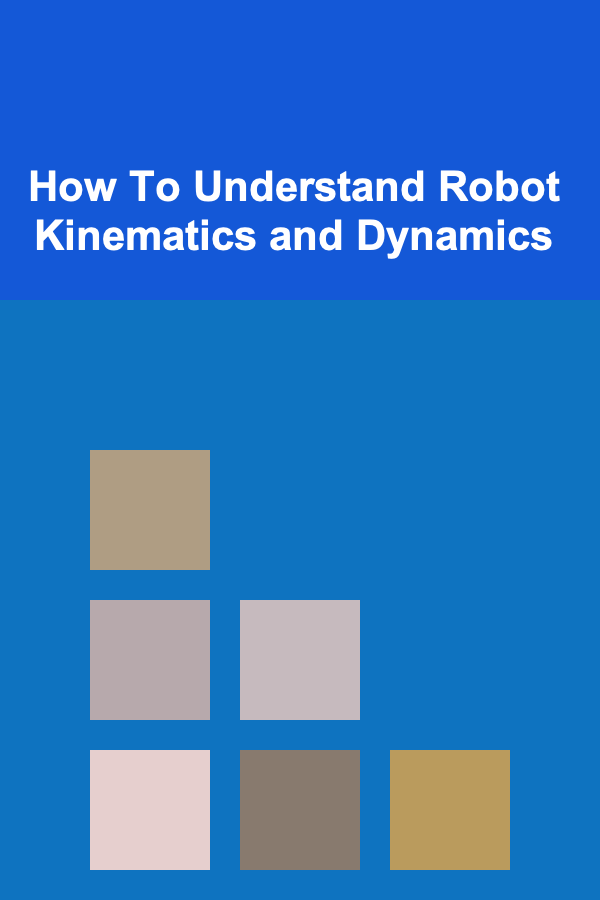
How To Understand Robot Kinematics and Dynamics
ebook include PDF & Audio bundle (Micro Guide)
$12.99$11.99
Limited Time Offer! Order within the next:

Understanding robot kinematics and dynamics is crucial for anyone involved in robotics, whether in the fields of mechanical engineering, artificial intelligence, or automation. These two essential concepts describe the behavior of robots in motion, but they deal with different aspects of movement and interaction with the environment. While kinematics focuses on the geometry of motion, dynamics looks at the forces that cause movement. In this article, we will delve into both subjects, explaining their significance, key principles, and how to approach them in the context of robotic systems.
What is Robot Kinematics?
Kinematics is the branch of mechanics that deals with the motion of objects without considering the forces that cause the motion. In the context of robotics, it refers to the study of the motion of robots' parts, typically articulated arms or mobile platforms. The primary objective of robot kinematics is to describe how different parts of a robot move relative to one another, which is essential for designing robots that can move accurately in a given environment.
1.1 Types of Kinematics
There are two main types of kinematics in robotics:
1.1.1 Forward Kinematics (FK)
Forward kinematics involves computing the position and orientation of the end effector (i.e., the tool or gripper) based on the joint angles or positions of the robot's actuators. This is typically the easier of the two to solve. Given the joint parameters, forward kinematics allows us to predict where the end effector will be in space.
For example, consider a robotic arm with several joints. By knowing the angles of these joints (the angles between links), forward kinematics can be used to calculate the position of the robot's hand. The transformation of joint positions to end effector position can be represented using transformation matrices.
1.1.2 Inverse Kinematics (IK)
Inverse kinematics is the opposite of forward kinematics. It involves determining the joint parameters that will position the end effector at a specific location in space. This is often more complex than forward kinematics and may have multiple or no solutions. It's used, for instance, in applications where the robot's hand needs to be placed at a specific position to manipulate an object.
The main challenge in inverse kinematics is that not all end effector positions can be achieved with a given robot configuration due to constraints like joint limits, workspace limits, and the non-linear nature of the problem. Several algorithms, such as the Jacobian inverse and iterative methods, are used to solve the inverse kinematics problem.
1.2 Kinematic Chains
Robots are often designed with a series of interconnected links, referred to as a kinematic chain. These chains consist of rigid bodies (links) and joints, which can be either revolute (rotating) or prismatic (sliding). Understanding the robot's kinematic chain is key to modeling its motion.
The concept of degrees of freedom (DOF) is central to kinematics. A robot's degrees of freedom refer to the number of independent movements it can make. For instance, a robot arm with six degrees of freedom can perform translations and rotations in three-dimensional space, much like a human arm.
1.3 Transformation Matrices
In robotic kinematics, transformations between different coordinate systems are crucial. A robot's various parts, such as the base, joints, and end effector, are each described in their own coordinate system. Transformation matrices are used to describe how one coordinate system relates to another.
For example, to compute the position of the end effector of a robot arm, we combine the individual transformations between successive links using matrix multiplication. These transformations include translations and rotations, which together define how the end effector moves relative to the robot's base frame.
The homogeneous transformation matrix is commonly used to represent these transformations. It combines both rotation and translation into a single matrix, which simplifies calculations in 3D space.
1.4 The Role of Kinematics in Robot Design
Kinematics plays a fundamental role in robot design. By understanding the kinematic constraints, designers can choose the appropriate joints and actuators to achieve the desired motions. For instance, industrial robotic arms must be able to perform precise movements, and understanding the kinematic structure helps in optimizing the design for these tasks. Kinematics also helps to avoid collisions and ensure that the robot's movements are within feasible limits.
What is Robot Dynamics?
Whereas kinematics is concerned with motion, dynamics deals with the forces and torques that cause motion. In robotics, dynamics is used to model how the robot moves under the influence of forces such as gravity, friction, and the force applied by its actuators. A robot's dynamic behavior is crucial for tasks such as controlling the robot's velocity, ensuring stability, and designing controllers that can predict and adjust to external forces.
2.1 Types of Robot Dynamics
Robot dynamics can be classified into two primary categories:
2.1.1 Inverse Dynamics
Inverse dynamics involves calculating the required joint torques or forces to achieve a desired motion of the robot's end effector. It is the process of determining what forces (such as torques at the joints) are necessary to produce the desired acceleration and motion of the robot.
Inverse dynamics is used in the design of control systems, where the robot's motion needs to be precisely controlled. By knowing the robot's desired trajectory and kinematic parameters, inverse dynamics allows us to determine how much torque each motor must provide to achieve that motion.
2.1.2 Forward Dynamics
Forward dynamics is the reverse of inverse dynamics. It involves calculating the robot's motion (i.e., acceleration and velocity) given the forces and torques applied to it. This is a more complex problem and requires solving the robot's equations of motion, which often result from the interaction of multiple forces and torques acting on the robot's body.
The equations governing robot dynamics are usually derived from Newton-Euler or Lagrangian mechanics, two fundamental principles in classical mechanics. These equations describe the robot's motion by considering the mass, inertia, and forces acting on each of the robot's links.
2.2 Equations of Motion
To solve the dynamic problem, we need to describe the robot's system using equations of motion. These equations can be derived using various methods, the most common being:
- Newton-Euler Method: This method involves considering forces and torques acting on each link and using them to derive equations of motion for the entire robot. It provides a straightforward approach but can become complex for robots with many degrees of freedom.
- Lagrangian Method: The Lagrangian formulation is based on the principle of least action and involves computing the kinetic and potential energies of the system. It's widely used in robotic dynamics because it simplifies the system of equations and is well-suited for robots with complex constraints and interactions.
2.3 Dynamics and Control
Dynamics plays a critical role in robot control, particularly in tasks that require precise movements, such as grasping objects or performing delicate assembly tasks. A robot controller needs to take into account the dynamics of the system to accurately control the motion. This involves solving inverse dynamics problems to determine the required joint torques for a desired motion and forward dynamics problems to predict the behavior of the robot under external forces.
Dynamic models also help in developing adaptive and robust control strategies, especially when dealing with uncertainties or disturbances in the robot's environment. For example, a robot interacting with an unknown object must adapt to changes in forces applied to its end effector, and understanding the dynamics allows it to adjust its control actions accordingly.
2.4 The Role of Dynamics in Robot Design
Dynamics plays an important role in robot design, especially when dealing with systems that require high-performance motion. In applications such as autonomous vehicles or surgical robots, the dynamics of the robot determine how it responds to external disturbances, how it accelerates, and how it can maintain stability.
For example, in the design of an autonomous car, understanding the dynamics of the vehicle allows engineers to create control systems that ensure smooth, stable motion even when navigating difficult terrain. In the case of a surgical robot, the dynamic model helps ensure that the robot can perform precise motions with minimal disturbance or oscillation.
Kinematics and Dynamics in Robot Control
To build a functional and efficient robot, both kinematics and dynamics must be understood and integrated into its control system. The combination of these two areas allows robots to not only move but to move in a controlled and efficient manner.
3.1 Kinematic Control
Kinematic control focuses on controlling the position and orientation of the robot's end effector without explicitly considering the forces and torques required. It uses kinematic models to compute the necessary joint motions that will achieve the desired position or trajectory.
For instance, a robot arm used in a pick-and-place task may be controlled using inverse kinematics to determine the appropriate joint angles to place the gripper at a specific position. Kinematic control is often used in environments where external forces are minimal and the primary goal is to achieve specific positions.
3.2 Dynamic Control
Dynamic control, on the other hand, takes into account the forces and torques involved in achieving a given motion. Dynamic control systems use the robot's dynamic model to predict the forces required to follow a desired trajectory and to adjust the robot's actuators accordingly.
In applications such as walking robots or robots operating in unstructured environments, dynamic control is essential to ensure that the robot maintains balance and stability. For example, a bipedal robot uses dynamic control to adjust its gait and balance, taking into account the forces acting on its legs as it moves.
3.3 Combining Kinematics and Dynamics
The most advanced robots use a combination of kinematic and dynamic control to achieve high levels of performance. For example, a humanoid robot may use kinematic control for high-level tasks like reaching out and grasping an object but rely on dynamic control to ensure that it doesn't lose balance while performing those tasks.
This integration of kinematics and dynamics is essential for robots that operate in complex, real-world environments. By combining the two, robots can achieve precise movements while also being adaptive to the forces and dynamics of their surroundings.
Conclusion
Kinematics and dynamics are two fundamental pillars of robotics. While kinematics focuses on the motion of the robot's parts and the relationships between them, dynamics deals with the forces and torques that drive those motions. Understanding both areas is crucial for designing robots that can move accurately, efficiently, and safely.
As robots become more advanced, integrating kinematic and dynamic models into control systems will enable more sophisticated and adaptable robots. Whether in industrial, medical, or autonomous applications, mastering the principles of kinematics and dynamics will be key to advancing the field of robotics.

How to Maintain Your Home's Foundation to Avoid Expensive Repairs
Read More
How to Maximize Soundproofing in Older Homes
Read More
How to Store Books Without Overcrowding Your Space
Read More
How to Teach Kids About Money and Start Their Financial Education Early
Read More
How to Use Tax Preparation to Make Money
Read More
How to Grocery Shop for a Vegan Diet: A Comprehensive Checklist
Read MoreOther Products

How to Maintain Your Home's Foundation to Avoid Expensive Repairs
Read More
How to Maximize Soundproofing in Older Homes
Read More
How to Store Books Without Overcrowding Your Space
Read More
How to Teach Kids About Money and Start Their Financial Education Early
Read More
How to Use Tax Preparation to Make Money
Read More